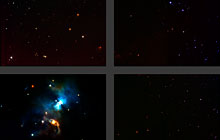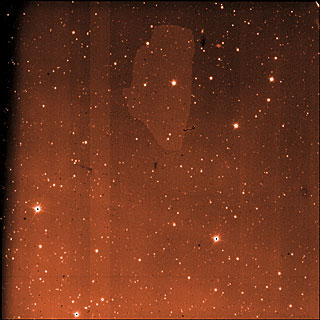HAWK-I
High Acuity Wide-field K-band Imager
 Under the watchful gaze of Giovanni Carraro and Petr Kabath, HAWK-I can be found perched on the side of Unit Telescope 4 (UT4, Yepun) of the Very Large Telescope (VLT) at the Paranal Observatory. “Its special four-chip design allows HAWK-I to collect breathtaking images covering a wide area of the sky, meaning that a whole nearby galaxy can fit in one single image!” comments Petr. The main function of this unique instrument, therefore, is to obtain images of extended objects (such as nearby galaxies or large nebulae), as well as individual stars and exoplanets.
Under the watchful gaze of Giovanni Carraro and Petr Kabath, HAWK-I can be found perched on the side of Unit Telescope 4 (UT4, Yepun) of the Very Large Telescope (VLT) at the Paranal Observatory. “Its special four-chip design allows HAWK-I to collect breathtaking images covering a wide area of the sky, meaning that a whole nearby galaxy can fit in one single image!” comments Petr. The main function of this unique instrument, therefore, is to obtain images of extended objects (such as nearby galaxies or large nebulae), as well as individual stars and exoplanets.
In order to peek through dust and to detect cooler stars and planets, HAWK-I observes in different parts of the near-infrared spectral range (0.9–2.5 μm). The detectors inside are cooled to approximately -168 degrees C; this allows a very “clean” image to be obtained by reducing the noise caused by the instrument’s own heat. Combined with the superb optical quality of UT4 and the excellent atmospheric conditions often prevailing at Paranal, this allows HAWK-I to obtain amazing quality images — this instrument truly does have the eyes of a hawk.
So what special prey has HAWK-I been able to capture? “HAWK-I helped to explain the spiral structure of galaxies,” says Petr. “Furthermore, it has unveiled the mystery of exoplanetary atmospheres and was also monitoring distant galaxies for supernovae explosions... And that is just a fraction of HAWK-I’s achievements!”
As if that weren’t enough, ESO engineers have recently fitted the hawk with lasers to make its eyes even sharper: GRAAL shoots four lasers into the sky to make artificial reference stars around HAWK-I’s field of view. These reference stars correct for the turbulence of the atmosphere over the full field of view.
Science highlights with HAWK-I
- Discovery that TRAPPIST-1 planets are probably rich in water (eso1805)
- First observations of light from a gravitational wave source (eso1733)
- Temperate Earth-sized worlds found in extraordinarily rich planetary system (eso1706)
- Deepenst ever look into Orion Nebula (eso1625)
- Three potentially habitable worlds found around nearby ultracool dwarf star (eso1615)
- HAWK-I produces the most detailed image of the Carina Nebula to date (eso1208)
- Spiral structures of galaxies shown in incredible detail (eso1042, eso1038, eso1020)
- Faint galaxies discovered that were missed by previous surveys (eso1013)
|
A raw image from one of the four detectors of HAWK-I The images taken with astronomical instruments are always in intensity scale: the information on the colours is obtained by taking exposures through different glass filters, in this case the near-infrared H filter. This image was used, together with many others, to produce the large mosaic of the Carina Nebula [eso1208a]. |
HAWK-IThe authoritative technical specifications as offered for astronomical observations are available from the Science Operation page.
|


